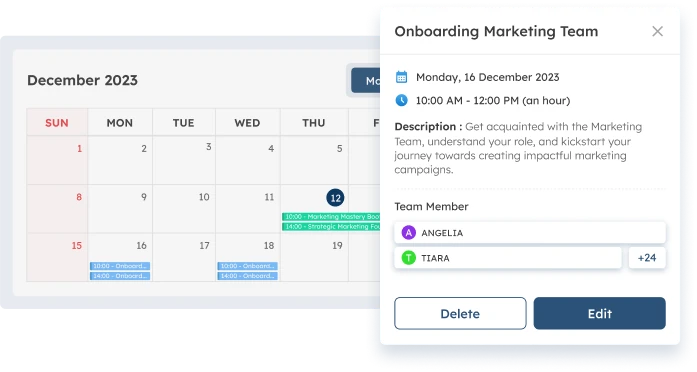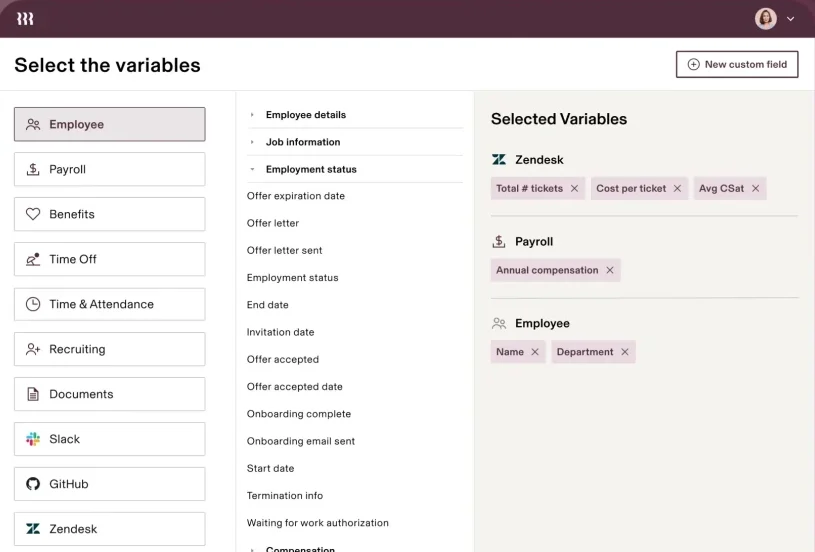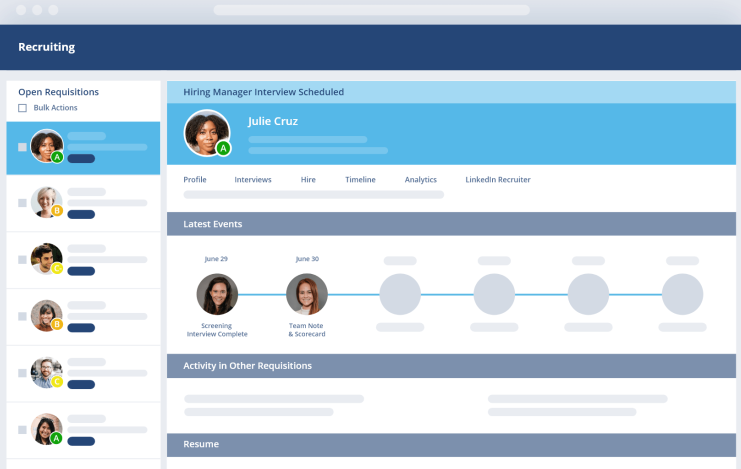Bringing new hires into the company can be a messy, paper-filled process, which often leaves a poor first impression. Many businesses are now turning to technology to solve this, where digital onboarding software helps manage the entire experience.
According to MOM, a first-time worker in Singapore, or a person returning to work after more than two years following the cancellation of their previous work pass, will attend a three-day Onboarding program. This program streamlines onboarding, offering a seamless and efficient experience for all employees.
And for that, this article discusses the best employee onboarding software in Singapore, such as ScaleOcean, BambooHR, Rippling, Gusto, ClearCompany, and others. We’ll go over major features and benefits to help you make an informed decision about transforming your onboarding into a strategic advantage for your company.
- Onboarding software is a digital platform that automates and manages the employee welcome process, from signing the offer letter to planning training programs.
- Discover the best employee onboarding software in Singapore 2025, such as ScaleOcean, BambooHR, Rippling, Gusto, ClearCompany, and others.
- How to choose the right onboarding software involves assessing your company size, onboarding type, integration needs, global hiring capabilities, and overall budget.
- ScaleOcean’s talent management software provides a comprehensive solution to streamline onboarding, boost engagement, and improve retention from day one.

What is Onboarding Software?
Onboarding software is a digital platform that automates and manages the employee welcome process, from signing the offer letter to planning training programs and managing all essential documents to ensure a successful integration.
The primary purpose of onboarding software is to simplify the integration process for new employees, ensuring a consistent and enjoyable experience for the employee, HR, and management while effectively integrating multiple company activities. Effective offboarding employee processes are key to ensuring smooth transitions when employees leave.
How Onboarding Software Works
Onboarding software streamlines the new-hire process by emailing important documents, such as contracts and tax forms, for digital signatures before the employee’s first day. This assures compliance with Singapore’s employment rules and makes the setup easier for both the employee and HR.
When an employee starts, onboarding software walks them through the first few days with checklists, training courses, and team introductions. This ensures a smooth and orderly onboarding process, which speeds up data processing and allows new personnel to integrate rapidly.
Benefits of Onboarding Software

Onboarding software provides numerous benefits, transforming an essential corporate function into a strategic growth tool. It increases efficiency and improves the employee experience by transforming onboarding from an administrative activity to a value-driven process. Let’s have a look at the main benefits:
1. Improved Efficiency
Automating repetitive tasks is a huge benefit, which lets your HR team get away from all that manual data entry and endless paperwork, giving them back time. They can really focus on more strategic initiatives then, rather than just always chasing signatures, which is a practical choice in most scenarios for HR onboarding software.
With a centralized onboarding system, all necessary information and documents are stored in one easily accessible place. It reduces confusion and ensures both the new hire and manager know what’s needed. This setup boosts productivity in device performance, contributing effectively.
2. Higher Retention
A strong onboarding experience really makes new employees feel valued and supported right from the very beginning. This positive first impression is super critical for long-term loyalty, you know, and can significantly reduce early turnover, which is what every company wants from their employee onboarding software.
When new hires feel connected to the company culture and their team quickly, they are just more likely to be engaged and committed to their roles, which makes sense. A structured onboarding process definitely helps build these connections, which we often see as a key feature of the best employee onboarding software.
3. Faster Time-to-Productivity
An effective onboarding system really provides new hires with all the resources and training they need, so they become productive members of the team much faster than they might otherwise. It sets clear expectations and gives them a roadmap for those first 30, 60, and 90 days, which is incredibly helpful for a new start.
By giving new hires access to essential information and learning materials right away, you really shorten that learning curve, which is always the goal. This means they can actually start contributing to team goals sooner, which is a practical benefit of using an onboarding system.
4. Enhanced Compliance
Onboarding involves a lot of legally required paperwork, everything from employment contracts to tax forms and all those policy acknowledgements. An onboarding system definitely helps ensure all these documents are completed, signed, and then stored correctly, which is a big relief for HR teams.
This onboarding software can also create an audit trail, which makes it super easy to track and prove that all those necessary steps were actually followed, which is really important. This capability is invaluable for mitigating legal risks, something you absolutely want to avoid in talent management.
5. Stronger Culture
Onboarding it’s really your first and arguably best chance to immerse a new employee in your company culture, which is a huge opportunity. The software itself can be used to share company history, mission, and values through engaging content, things as videos and personalized welcome messages.
It can also facilitate social connections, like introducing new hires to their colleagues and scheduling those important introductory meetings. This really helps them feel like a part of the team, you know, not just another new face, which is vital for engagement and retention. This boosts competitiveness and sustainable growth for the business.
Also Read: What Is Talent Management and How’s the Process?
Key Features of an Onboarding System
Onboarding software offers a variety of features, but only a few are essential for creating an effective system. Focusing on the right ones helps you choose the best software tailored to your needs. Let’s explore the key features:
1. Automation
A solid onboarding system thrives on automation, handling repetitive tasks like sending welcome emails and confirming completed items. According to WSG, roles like first-line support and basic query handling could be replaced by chatbots, allowing HR to focus on complex tasks.
By automating these processes, you’re basically guaranteeing consistency and drastically cutting down on human error, which is a real win. This means every new hire gets a reliably high-quality experience, right from day one. It allows employees to focus on their roles, making the process more efficient.
2. Customizable Content
Let’s face it, not every role or department is the same, so expecting a one-size-fits-all onboarding experience just isn’t practical. That’s why being able to customize content and workflows is such a crucial feature for any good system. It allows you to create personalized plans for different roles, ensuring a relevant experience.
When you’re looking at options, definitely prioritize software that makes it simple to create and assign unique training modules, documents, or tasks based on specific job roles or even different locations. This kind of flexibility really offers a solid way to integrate various company operational processes smoothly.
3. Task Management
Onboarding isn’t just one person’s job. It typically involves a whole cast of characters. The new hire, their manager, HR, and sometimes even IT. A really strong feature here is a centralized task management system or a comprehensive checklist. This ensures everyone knows their tasks and deadlines, preventing anything from being missed.
Those checklists bring a lot of transparency and accountability to the entire onboarding journey. It’s great because everyone involved can quickly see how things are progressing, which is super helpful. This definitely helps to increase overall efficiency and supports productivity across the team.
4. Employee Portal
Having a self-service employee portal is a game-changer, giving new hires one central spot for absolutely everything they might need. From ticking off tasks to grabbing company documents or even finding team contact info, it’s all there. This really empowers new employees to take ownership of their onboarding journey from day one.
Ideally, this portal should be super user-friendly and easily reachable from any device, which just makes sense. It cuts down on the constant stream of questions hitting HR, letting new hires feel a lot more independent. Ultimately, it ensures more accurate information is available and helps to truly support job productivity throughout the organization.
5. Integrations
No onboarding software should ever be an island. It really needs to play well with others in your HR tech stack. The ability to integrate seamlessly with existing systems like your HRIS, payroll, or applicant tracking system (ATS) is absolutely critical. This setup streamlines data flow, eliminating the need for duplicate data entry.
Really, seamless integrations just make for a far more efficient and connected HR tech ecosystem overall. Think about it, when a new hire’s profile automatically zips over to payroll, it saves tons of time and really slashes potential errors. It’s a pretty smart system that’s incredibly effective for maintaining overall data consistency.
10 Best Employee Onboarding Software in Singapore
With so many options available, it might be difficult to choose the best onboarding platform, particularly in Singapore. The region provides excellent systems, including specific ERPs for new hires. Let’s look at the finest employee onboarding software in Singapore:
1. ScaleOcean Talent Management Software

ScaleOcean’s talent management system provides limitless users with no additional fees or hidden charges. It offers industry-specific solutions, adaptable settings, and AI-powered insights to facilitate onboarding. The solution is scalable, enabling organizations to achieve faster ROI and growth.
ScaleOcean offers a free demo, allowing organizations to see firsthand how its onboarding software can reduce operations and increase staff retention. ScaleOcean is also eligible for CTC grants, which allow businesses to incorporate HR solutions while receiving government funding.
Key Features:
- Automated Onboarding Process: Automates onboarding from pre-boarding to post-onboarding, including documents, forms, and feedback.
- Centralized Employee Data Integration: Employee data syncs automatically with HRIS, payroll, and other systems for easier access.
- Employee Experience Management: A centralized dashboard monitors progress, self-service access, and feedback, improving onboarding transparency.
- Automated Workflows: Streamlines tasks and processes by automating workflows, increasing efficiency during onboarding.
- Reporting and Analytics: Provides detailed insights through reporting and analytics to track onboarding success and employee engagement.
| Pros | Cons |
|---|---|
|
|
Best For: ScaleOcean Talent Management Software is best for growing businesses and enterprises seeking a scalable, cost-effective onboarding solution. It’s ideal for companies in various industries, offering tailored solutions, AI-powered insights, and eligibility for government funding through CTC grants.
2. BambooHR Software
BambooHR is a user-friendly platform, which makes it a go-to for many small to medium-sized businesses. Their onboarding software really leans into the human side of things, offering features like new hire packets and “get-to-know-you” emails. This setup improves data flow and removes duplicate data entry.
It does a great job of streamlining all that paperwork and really sets new hires up for success with straightforward checklists. BambooHR integrates with its own HRIS, which means it often becomes a cohesive all-in-one solution for quite a few companies out there.
Key Features:
- User-friendly interface.
- New hire packets and “get-to-know-you” emails.
- Streamlined data flow.
- Task checklists for new hires.
- Integrates with its HRIS system for a cohesive solution.
| Pros | Cons |
|---|---|
|
|
Best For: BambooHR is ideal for small to medium-sized businesses looking for a user-friendly, easy-to-implement onboarding solution that integrates well with HRIS systems to enhance employee experience and streamline administrative tasks.
3. Rippling Onboarding System

Rippling is a powerhouse, bringing together HR, IT, and Finance in one place, and its onboarding features are exceptionally great. It can pretty much automate everything, from sending out offer letters to getting a new hire’s laptop ordered and set up. It is a great choice for businesses aiming to automate the entire employee lifecycle.
The real magic here is the deep integration across various business functions. When you onboard someone using Rippling, things like their payroll, benefits, and even company apps are all automatically configured. This comprehensive level of automation really is a significant time-saver for any growing company.
Key Features:
- HR, IT, and finance integration.
- Automated onboarding tasks like offer letters and equipment setup.
- Employee lifecycle management automation.
- Payroll and benefits setup automation.
- Deep integration with business applications.
| Pros | Cons |
|---|---|
|
|
Best For: Rippling is best suited for mid to large-sized businesses looking for a comprehensive HR and IT solution, capable of automating the entire employee lifecycle, including payroll, benefits, and organizational setup.
4. Gusto HR Tools
While Gusto is mostly recognized for its payroll services, it actually brings some really solid HR tools to the table, including onboarding. It’s popular with small businesses, particularly in the US, and its core features are useful for any small team. The platform streamlines managing new hire paperwork and tracking compliance requirements.
With Gusto, you can easily send out offer letters and whip up custom onboarding checklists, which is super handy. It really makes sure all the basic stuff, like I-9 forms and getting direct deposit set up, is handled efficiently and without a fuss. Overall, it’s a great, simple yet effective tool for foundational onboarding tasks.
Key Features:
- Automated new hire paperwork and compliance management.
- Customizable onboarding checklists.
- Direct deposit and tax form management.
- I-9 and W-2 management.
- Seamless integration with payroll systems.
| Pros | Cons |
|---|---|
|
|
Best For: Gusto is best for small businesses in the US seeking a simple, efficient solution for managing employee onboarding and compliance, especially those focused on payroll and basic HR tasks.
5. ClearCompany Talent Management Platform

ClearCompany provides a comprehensive talent management platform, and what’s particularly strong about it is the focus on aligning employees with company goals right from the start. Their onboarding software is actually built to connect new hires to the company’s mission and what’s expected of them performance-wise.
You’ll find standard features like new hire forms, task management, and equipment provisioning checklists here. What’s also quite helpful are the tools for checking in with new hires at those crucial 30, 60, and 90-day marks, which contribute to improving retention over time.
Key Features:
- Comprehensive talent management platform.
- New hire forms and task management.
- Integration with company goals.
- 30, 60, and 90-day check-ins.
- Employee performance tracking tools.
| Pros | Cons |
|---|---|
|
|
Best For: ClearCompany is best for mid to large-sized businesses seeking a comprehensive solution for talent management and employee retention, particularly those looking to integrate onboarding with company performance goals.
6. Greenhouse Onboarding Software
Greenhouse is widely known for its applicant tracking system (ATS), but it also offers a great, dedicated onboarding product. It’s designed to make the jump from candidate to new hire feel incredibly seamless, which is a massive plus. Recruitment data automatically transfers, creating a unified employee record without complications.
Their onboarding tools are fit for crafting a really structured and welcoming experience. You can easily put together welcome packets and assign tasks, making sure every new hire gets exactly what they need right from the start. This creates a consistent candidate-to-employee journey, which is valuable for HR professionals.
Key Features:
- Seamless transition from candidate to new hire.
- Recruitment data automatically transferred.
- Structured onboarding experience.
- Customizable task assignment and welcome packets.
- Unified candidate-to-employee journey.
| Pros | Cons |
|---|---|
|
|
Best For: Greenhouse is best for businesses that need a well-integrated onboarding and applicant tracking system, especially those aiming to streamline their hiring and onboarding process in a structured, cohesive way.
7. ADP HR Onboarding Platform
ADP, being a global leader in HR and payroll, naturally offers a platform that includes some great onboarding features. It’s particularly well-suited for larger organizations, especially those grappling with complex compliance needs. The system handles paperwork electronically, ensuring compliance with regulations.
ADP’s onboarding solution truly helps new hires feel prepared and welcomed even before their actual first day, which is important for a good start. It integrates with ADP’s existing payroll and benefits administration, creating a unified HR ecosystem that works well for larger enterprises.
Key Features:
- Handles employee paperwork electronically.
- Integrates with ADP’s payroll and benefits system.
- Global compliance management.
- Employee self-service portal.
- Detailed reports on employee status.
| Pros | Cons |
|---|---|
|
|
Best For: ADP is best for large enterprises with complex HR needs, particularly those in need of comprehensive compliance management, payroll integration, and a unified HR ecosystem across multiple locations.
8. JustLogin HR Onboarding Solution
JustLogin is a cloud-based HR solution with a great footprint across Asia, especially right here in Singapore. Their onboarding module is specifically crafted to simplify the process for local businesses, which is a major advantage. It basically helps you manage the entire employee lifecycle from one single, integrated platform.
You can easily create onboarding checklists and feel confident that all the necessary employee information is captured accurately with JustLogin. As a prominent regional player, they’ve got a really solid grasp of local compliance needs, which is invaluable for businesses operating here.
Key Features:
- Cloud-based HR solution for local businesses.
- Compliance with local Singapore regulations.
- Employee data management automation.
- Integrated onboarding checklists.
- Simplifies employee lifecycle management.
| Pros | Cons |
|---|---|
|
|
Best For: JustLogin is best for small to medium-sized businesses in Singapore seeking an easy-to-use HR platform with strong compliance support and effective employee lifecycle management.
9. PeopleHum HR Platform
PeopleHum is an AI-driven HR platform that aims to put the employee experience at the forefront, which is a refreshing approach. Its onboarding software is crafted to be both engaging and intuitive. It stands out by using AI to create personalized onboarding journeys and predict potential disengagement.
The platform prioritizes making new hires feel connected and engaged right from day one. It includes features for social onboarding and continuous feedback, fostering a sense of belonging. This approach helps strengthen the company culture overall.
Key Features:
- AI-driven personalized onboarding journeys.
- Continuous employee feedback tools.
- Social onboarding features for team connection.
- Employee engagement tracking.
- AI predictions for potential disengagement.
| Pros | Cons |
|---|---|
|
|
Best For: PeopleHum is best for mid to large-sized businesses looking to enhance employee engagement and retention using AI-driven personalized onboarding and real-time feedback tools.
10. QuickHR Software
QuickHR is another great Singapore-based HR software provider that brings a comprehensive suite of tools, and yes, that includes solid onboarding capabilities. It’s purpose-built to address the unique needs of businesses right here in Singapore, especially when it comes to local regulations like CPF compliance.
Its onboarding module pretty much automates the entire process of collecting employee data and handling paperwork. This automation really helps ensure new employees get a smooth and efficient start to their journey with your company. The system is known for being comprehensive and localized, benefiting businesses in the area.
Key Features:
- Comprehensive HR software for Singapore-based businesses.
- Local compliance management, including CPF.
- Onboarding checklist automation.
- Employee data collection and management automation.
- Smooth integration with existing HR processes.
| Pros | Cons |
|---|---|
|
|
Best For: QuickHR is best for small to medium-sized businesses in Singapore that need a straightforward, compliance-focused HR solution with streamlined onboarding processes.

How to Choose the Right Onboarding Software
Selecting the appropriate onboarding software is critical for HR productivity and employee satisfaction. It contributes significantly to corporate growth and ongoing improvement. When choosing a platform, keep these key considerations in mind to achieve the best fit:
1. Recognize Your Company Size
It’s pretty obvious, but a small startup with just ten people won’t have the same requirements as a massive company with thousands of staff. Small businesses seek ease of use and affordability, while larger ones require powerful features like customization, reporting, and handling complex structures.
Whatever onboarding system you go with, you really need to be sure it can grow alongside your company. What works today has to also be able to support your future growth, and that’s actually a super important thing for long-term success.
2. Clarify The Onboarding Type You Implement
Think about your workforce setup and how you actually bring people on board. Are your folks fully remote, everyone in the office, or running a hybrid model? Your chosen HR onboarding software needs to genuinely support your specific approach, maybe with some really strong digital tools for remote employee engagement.
If your company has distinct onboarding paths for various employee types, like full-timers compared to interns, the software really ought to offer that kind of flexibility. The system should definitely be able to help boost productivity in various scenarios, making things smoother for everyone.
3. Check its IT Integration Capability
Integrations, as we’ve touched on, are absolutely vital for a smooth HR tech ecosystem. It really is. Before you settle on an onboarding system, you should list out all your current platforms, things like your HRIS, payroll, and ATS, to make sure your chosen solution integrates without a hitch, avoiding those frustrating data silos.
Without proper integration, you’re looking at a lot of manual data entry, and that kind of defeats the whole purpose of investing in the software in the first place, doesn’t it? This is actually a really crucial thing to check for, especially if you’re aiming for true operational efficiency.
4. Built to Handle Global Hiring
For companies bringing on employees in various countries, you absolutely need an onboarding platform that’s designed for global operations. This includes multi-language support and handling country-specific compliance documents, essential for global talent management.
Having an onboarding system ready for global use will honestly save you a lot of headaches down the line as your company expands. It really helps ensure a consistent experience for all your new hires, no matter where they are, and makes sure the information you’re getting is trustworthy for global businesses.
5. Customize Your Budget
And finally, don’t forget to look at your budget, that’s a big one. Onboarding software is often priced per employee per month (PEPM). Some vendors offer tiered packages. Be sure to understand all costs, including setup fees and support charges, to avoid unexpected expenses.
While cost is definitely important, it’s often better to really focus on the overall value the employee onboarding software brings to your team. The best choice, more often than not, is the one that gives you a good balance of features, how easy it is to use, and a fair price for what your specific needs are.
Conclusion
Choosing the correct onboarding software represents a strategic investment in your company’s most valuable asset, its employees. The appropriate technology may enhance efficiency, compliance, and business culture, ensuring a smooth transition for new employees and laying the groundwork for long-term success.
ScaleOcean provides robust HR solutions, such as talent management software, that are intended to streamline onboarding and personnel management. Businesses can gain personal experience with the system’s capabilities and benefits by taking advantage of a free demo offer, which can help them establish a productive and engaged staff.
FAQ:
1. What software is used for onboarding?
Onboarding software helps automate tasks like document management, training, and compliance tracking. Many businesses use solutions like ScaleOcean, which offers a comprehensive, easy-to-use platform that streamlines the entire onboarding process, from paperwork to integration.
2. How to automate employee onboarding?
Employee onboarding can be automated by using software that manages tasks like document submission, training, compliance tracking, and workflow automation. These systems reduce manual effort and help HR teams manage large volumes of new hires more effectively.
3. What is an example of digital onboarding?
Digital onboarding allows new hires to complete paperwork, access training materials, and integrate with the company culture online. A good example is ScaleOcean’s platform, which automates the onboarding process, ensuring a smooth and efficient transition for new employees.
4. Is digital onboarding safe?
Yes, digital onboarding is safe when using platforms with proper security measures, including data encryption, secure document storage, and compliance with privacy regulations. These systems are designed to protect sensitive employee data and ensure secure handling throughout the process.







 PTE LTD..png)
.png)

.png)








.png)
.png)
















